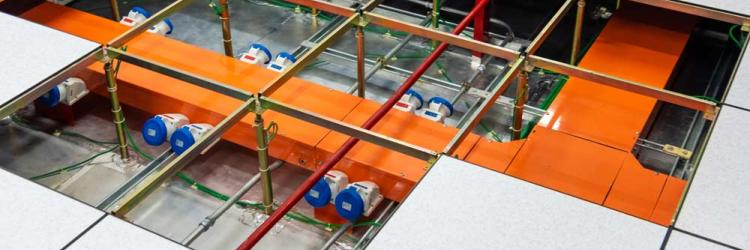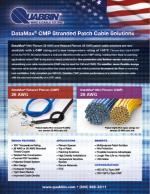DataMax Mini-28 AWG stranded plenum patch cable meets the loss-prevention requirements of insurance companies, as well as the demands of Power over Ethernet (PoE) connections short-space cables, where inflexible solutions do not work.
Plenum cable (CMP) is typically used within a building’s plenum spaces, which provide a path for heated or conditioned air and returned airflow. Standards mandate that cables going into these spaces have low-smoke and low-flame characteristics. This mitigates the chance fire or smoke will spread throughout the building via these pressurized airflow pathways.
Plenum-rated cable meets a higher safety standard than both CM and riser-rated cable (CMR): it is fire-resistant and produces less smoke than other cable jackets. The 23 American wire gauge (AWG) cables rated for plenum use have almost exclusively been solid cable. Solid cable is inexpensive and carries signals over long distances, but it is not flexible and can break under duress. The stiffness of the cable can also compromise connections when bent, causing plugs to pull out of jacks.
There is a plenum-rated stranded solution — the DataMax Mini-28 AWG stranded patch cable is the first of a series of stranded CMP offerings from Quabbin Wire & Cable Co. The Telecommunications Industry Association’s (TIA) 2018 approval of the ANSI/TIA-568-C.2 standard recognized 28 AWG stranded patch cable, permitting more options and cables better suited for the space than previous technologies.
DataMax Mini-28 AWG stranded plenum patch cable meets the loss-prevention requirements of insurance companies, as well as the demands of Power over Ethernet (PoE) connections short-space cables, where inflexible solutions do not work.
More data means higher risks
Given the unprecedented growth in critical business data over the past decade, the loss of IT equipment in a fire is potentially catastrophic. Physical damage and losses due to downtime and data recovery are major risks. Building fires have many potential causes, including electrical failure, overhead electronics and wiring malfunctions, and a multitude of other sources from building systems or occupants.
Plenum space particularly increases the risk of fire for valuable server rooms. Wire and cable used in plenum spaces must be plenum-rated for low smoke and low flammability. Using plenum-rated cables in other spaces further minimizes fire risk and damage.
Stranded vs. solid cable
Patch cords made with stranded wire better maintain performance when moved than cables made with solid conductors. Solid conductor cables bend permanently or hold a bend, while stranded patch cord recovers and can be easily bent again. Consequently, stranded patch cords put less stress on a jack and are also easier to route in wire management systems given their flexibility and pliability.
Plugs designed for stranded wire typically pierce the wire, and plugs meant for horizontal cable contact the outside of the conductor. There is more contact area with stranded wire and if the wire is tinned, there is better corrosion resistance at the contact point. These factors lead to a lower contact resistance increase with time, which is important when terminating the smaller 28 AWG wire.
Inside and outside plenum spaces
Plenum-rated cable has insulation made of highly flame-resistant material, which endures higher temperatures and emits less smoke. Non-plenum cable is widely used since it is considerably less expensive than plenum cable. However, insurance companies have begun requiring the use of the plenum cables in schools and hospitals, where smoke emissions from a fire could be especially lethal.
CMP is also finding greater use outside plenum spaces where equipment preservation in the event of a fire is a primary consideration. DataMax® CMP also has higher temperature rating benefits for use in patch cable for PoE applications. Its high safety ratings make it suitable for riser cable and standard cable situations.
With insurance rates on the rise, building owners are increasingly choosing plenum-rated cable as the best long-term decision. Cable selection for specific applications is governed by many industry and government organizations. Specifying or committing to use CMP-rated cable throughout a project is an easy way to streamline efforts for installers and designers.
Cable jacket ratings
The National Electric Code (NEC), published by the National Fire Protection Association (NFPA), contains minimum standards for electrical wiring. Although it is a collection of guidelines rather than law, almost all cities, states and towns use NEC guidelines in their building codes.
Cable jackets protect against moisture, UV rays and physical damage. In the U.S., almost all cable jackets used for low-voltage applications are made from flexible, low-cost PVC. NEC ratings identify the properties of a cable’s jacket so that proper wiring is selected based on the application environment.
Common cable jacket ratings necessary for use in walls or ceilings include:
- CL, CM and CMG: Suitable for use in all ordinary situations, CL cables are used for audio/visual applications and CM and CMG are used for communications applications. They must pass a vertical tray flame test. Cables with these three ratings can be installed in the wall or ceiling.
- CMR: A cable with a CMR rating can be used in risers of commercial buildings since they limit the spread of flames better than cables in the previous group. They can be installed anywhere except plenums.
- CMP: CMP communications cable can be used in plenum spaces and anywhere that CM and CMR cable can be used. CMP jacket materials slow the spread of flames and emit minimal smoke when burned.
Datacenter reliability and safety
Underwriters Laboratories (UL) offers the UL 3223 certification program that concentrates on data center performance and safety. UL 3223 is currently the most comprehensive certification program for data centers as it considers the strength and resiliency of a facility’s network, human protection and security systems, as well as its sustainability and commissioning.
Standards
Approved by the TIA’s TR-42.7 Copper Cabling Systems Subcommittee in 2018, TIA-568.2-D is a revision to the 568 cabling standard that recognizes 28 AWG patch cords. Previously the TIA had recommended only 22 AWG to 26 AWG for balanced twisted-pair cables.
The addition of 28 AWG guidance is important for high-density applications where congestion, airflow and sharp bend radii are major considerations. Their smaller diameter allows 28 AWG patch cords to be used in places where 22 AWG to 26 AWG may be difficult or impossible to deploy.
This standard specifies minimum requirements for balanced twisted-pair telecommunications cabling (e.g., channels and permanent links) and components (e.g., cable, connectors, connecting hardware, cords and jumpers) used up to and including the telecommunications outlet and connector, and between buildings in a campus environment. The standard also specifies measurement procedures for all transmission parameters.
NFPA standards
Building cabling involves a myriad of standards. NFPA 75, for example, establishes minimum requirements protecting information technology equipment and IT equipment areas from damage by fire, smoke, corrosion, heat and water.
Although the specifications in NFPA 75 are current standards, they could become code if state governments choose to enact them as legislation as they have with NFPA 70, which all 50 states have adopted for the installation of electrical conductors, equipment and raceways.
The spaces above suspended ceilings are subject to specific regulations in NFPA 90A, limiting the presence of combustible materials. Raised areas beneath floors are subject to NFPA 75 and the NEC code. Materials used in plenum spaces, including wire and cables, must be specifically rated for use in those spaces and must exhibit low flame spread and smoke production properties and limited potential heat.
Local fire marshal codes
When installing low-voltage cable, county, municipal and state building codes come into play. Fortunately, most codes are based on model codes maintained by regional authorities. A major code item is always fire stopping, especially in terms of the use of appropriate materials. The second major area is compliance with the NEC. Most local fire marshal codes are based on the NEC guidelines.
Plenum cables vs. low smoke zero halogen (LSZH) cables
| Cable Rating | Flame Test | Low Toxicity | Low Smoke |
|---|---|---|---|
| Plenum | NFPA 262 (UL-910 Steiner Tunnel) | X | |
| LSZH | IEC 60332-2-2 or IEC 60332-3-24 | X | X |
| Riser | UL-1666 (Vertical Shaft) |
28 AWG CMP cables
Quabbin DataMax Mini 28 AWG Cat 6 F/UTP and Cat 6a F/UTP patch cables now feature a CMP rating and a reduced diameter profile.
They are ideal for use in patching applications where a CMP rating is mandated, or where fire protection, limited smoke emissions and streamlined CM and CMR cable requirements are desired.
Given their smaller and flexible design, cable density is improved and increased air flow for rack ventilation is maximized.
Applications include plenum spaces, top-of-rack, patching solutions, high-density installations, temperature-sensitive spaces, secure networks and PoE. Ratings include NEC (ETL)-type CMP and CEC C(ETL)-type CMP.
The DataMax Mini-6 and 6a stranded solutions are the first available from Quabbin to be specifically designed for plenum spaces. Meeting the safety requirements of data centers, universities and corporate buildings, insurance companies, certification programs and federal and local standards, the CMP cable can be used in place of all CM and CMR cables. The flexible deployment of CMP cables means they can be used entirely in a new construction, offering savings by purchasing the cable in bulk.
Conclusion
Unfortunately, fires in data centers do happen. Not only is there potential for property and equipment damage and human injury, the resulting losses due to downtime are staggering. According to a recent Underwriters Lab report: “With an average total cost of nearly $700,000 (USD) per downtime incident, protecting data centers from downtime and service outages is an essential requirement for both businesses and consumers.”
Insurance providers are beginning to add hefty premiums against potential property, equipment and human losses. However, CMP cables reduce the risks associated with fire, and new product offerings from Quabbin provide the latest certified CMP technology available.
For more information on how the Quabbin DataMax Mini-28 AWG Stranded Plenum can be used in specific applications, visit DataMax.






